
For the month of July 2023, we have compiled an exclusive collection of astronomical occurrences. The majority of these celestial events will be observable to the unaided eye! To effortlessly locate planets, stars, comets, and other cosmic entities, we highly recommend utilizing the interactive sky map provided by the Sky Tonight application.
Astronomical events in July 2023
Please take note that this information is specific to regions located at mid-latitudes. To determine the exact time when a particular event can be observed from your location, utilize the Sky Tonight app.
- July 1: Venus (sidereal magnitude -4.7) will be within 3°36′ of Mars (sidereal magnitude 1.7); the Moon will be within 1°30′ of Antares (sidereal magnitude 1.1).
- July 3: The Deer Moon (Super Moon).
- July 7: The Moon will be within 2°42′ of Saturn (sidereal magnitude 0.8).
- July 10: The Moon will be in its last quarter; Mars (sidereal 1.7) will be within 0°36′ of Regulus (sidereal 1.4); the peak of the July Pegasids meteor shower.
- July 11: Jupiter (sidereal magnitude -2.3) will be 2°12' away from the Moon.
- July 13: The Pleiades (sidereal magnitude 1.2) will be 1°42' away from the Moon.
- July 14: The star cluster The Nursery (sidereal magnitude 3.1) will be 0°12' away from Mercury (sidereal magnitude -0.7).
- July 16: Regulus (sidereal magnitude 1.4) will be 1°42' away from Venus (sidereal magnitude -4.7).
- July 17: It will be a New Moon.
- July 19: Mercury (sidereal magnitude -0.4) will be 3°30' away from the Moon.
- July 20: The Moon will be 4°12' away from Regulus (sidereal magnitude 1.4) and 7°51' away from Venus (sidereal magnitude -4.6).
- July 21: Mars will be only 3°18' away from the Moon, with a sidereal magnitude of 1.8.
- July 22.: In the evening, there will be a mini-alignment of Mars, Venus, and Mercury. Additionally, Venus will begin its retrograde motion.
- July 25.: The Moon will be in its last quarter and will pass 2°48' from Spica, which has a sidereal magnitude of 1.0.
- July 28: The Moon will come within 1.3° of Antares, which has a sidereal magnitude of 1.1. Additionally, Mercury (sidereal -0.1) will pass 1°18' from Regulus (sidereal 1.4). There will also be peaks of meteor streams, including the Southern Piscids and the July γ-Draconids.
- July 30.: The meteoroid activity will peak for the Southern δ-Aquariids and the α-Capricornids.
Planets in July 2023
Northern Hemisphere
Witness Mercury (with a sidereal magnitude of -0.3) during the evening hours as it appears low in the western sky in the constellation Leo towards the end of the month. In the same constellation, you can also spot Venus (along with the red planet) and Mars (during the beginning and middle of the month). However, these planets will only be visible for a short period of time, not exceeding an hour. Moving towards the morning hours, you can find Jupiter in the eastern sky, located in the constellation of Aries. Another planet worth observing is Saturn (-0.8), which can be seen in the southeast region of the sky in the constellation Aquarius from early to mid-month. As the month progresses, Saturn will become visible throughout the night. To locate Uranus (with a magnitude of 5.7), use binoculars in the morning and look towards the eastern sky in the constellation Aries. Lastly, the fainter planet Neptune (with a magnitude of 7.9) can also be observed in the morning hours, located in the constellation Pisces.
Southern Hemisphere
In the middle of the month, you can catch a glimpse of Mercury (with a sidereal magnitude of -0.3) in the evening sky, just above the northwestern horizon in the constellation of Leo. However, please note that the planet is only visible for a brief period of time, no more than an hour. Additionally, in the same area of the sky, you can also spot Venus (with a magnitude of -4.7) and Mars (with a sidereal magnitude of 1.8). They will be visible in the evening hours. If you shift your gaze to the morning sky, you will find Jupiter shining brightly with a magnitude of -2.1 in the constellation of Aries. Another planet, Saturn, can also be observed in both the evening and morning skies. It will be located in the constellation of Aquarius and has a sidereal magnitude of 0.7. Moving further up, you can spot Uranus in the northern sky during the morning hours. It will be in the constellation of Aries and has a magnitude of 5.7. Lastly, Neptune can be seen in the constellation of Pisces during the nighttime and morning hours. It has a sidereal magnitude of 7.9. Please keep in mind that binoculars or a telescope will be necessary to observe Uranus and Neptune.
Constellations in July 2023
July (the summer season in the Northern Hemisphere) presents the ideal opportunity to witness the splendor of three distinct constellations: the magnificent Swan, the captivating Lyra, and the majestic Eagle. Meanwhile, in the Southern Hemisphere, where July marks the arrival of winter, stargazers will be treated to the awe-inspiring sight of Scorpius, Sagittarius, and Serpentor, gracefully adorning the celestial expanse. For a comprehensive understanding of the constellations that dominate the night sky during other seasons, we invite you to peruse our extensively researched articles dedicated to both the Northern Hemisphere and the Southern Hemisphere.
July 2023 Super Moon
In July, the Moon will reach its full phase and come closest to Earth in its orbit. This means that the Full Moon in July will be 5.8% larger and 12.8% brighter than a regular moon. Some may consider this event the first super moon of 2023, depending on the definition they use. According to the astronomical definition, this is indeed a super moon. However, if you follow the astrological definition created by Richard Nolle, then the first super moon will occur in the following month. To fully understand this terminological confusion, we recommend reading our dedicated article.
Unique Mini Planetary Alignment in July 2023
On the evening of July 22nd, an extraordinary celestial event will unfold as Mercury, Venus, and Mars align in the sky. This rare phenomenon will be visible in the western horizon approximately one hour after sunset. The three planets will converge in the Leo constellation, near the brilliantly shining star, Regulus. Adding to the spectacle, our very own natural satellite, the Moon, will also grace the vicinity.
It is worth noting that the optimal viewing date, when the planets appear in the narrowest region of the sky, varies depending on your location. We have provided specific observation dates for various locations in our article. For an accurate depiction of how the alignment will appear from your particular area, we recommend utilizing the Sky Tonight app.
Comets in July 2023
In all likelihood, we won’t have the opportunity to witness any dazzling comets until October 2024. At present, all comets that are visible require the use of a telescope or binoculars, as well as some observational expertise. However, if you’re up for a more challenging endeavor, there are some celestial objects worth observing this month.
Comet C/2021 T4 (Lemmon) will be observable to Southern Hemisphere observers until September. It will reach perihelion on July 31 and make its closest approach to Earth 11 days earlier, on July 20. During that time, the comet will achieve a magnitude of 8 and can be spotted through binoculars from areas that are not affected by light pollution.
Comet Hartley 2, also known as 103P/Hartley or Hartley-2, passes through the inner solar system approximately every 6.5 years. In 2023, it will make a favorable appearance for observations as it comes close to Earth at a distance of about 0.39 a.u. This will be the closest the comet will come to Earth in the 21st century. It is expected that 103P/Hartley will increase in brightness to approximately the 7th magnitude. From July to December, the comet will be visible from both hemispheres, although it will be higher in the sky in northern latitudes. If you have binoculars, you can see 103P/Hartley – simply use the Sky Tonight app to find its location and observe the comet from dark areas.
Observers in the Southern Hemisphere will have the opportunity to observe comet 185P/Petriew in early August. However, its visibility this year will not be optimal. On July 12, when the comet reaches perihelion, it will be at a considerable distance from Earth (over 1.5 astronomical units). It is anticipated that the comet will have a brightness slightly exceeding the 12th magnitude.
Meteor showers in July 2023
July 2023 will bring five meteor showers that are set to peak at various times throughout the month. In the early part of the month, viewers in the Northern Hemisphere will have the chance to witness the relatively faint July Pegasids, with an expected maximum of 5 meteors per hour. However, the most exciting events are anticipated towards the end of July.
On July 28th, both the Southern Piscids and the July γ-Draconids will reach their peak activity, each producing around 5 meteors per hour. Two days later, on July 30th, the Southern δ-Aquariids (25 meteors per hour) and the α-Capricornids (5 meteors per hour) will reach their peak activity. It should be noted that the presence of a nearly full Moon might hinder observations. As a result, it is recommended to look for these “shooting stars” in the morning, after the Moon has set. For more tips on observing meteor showers, please refer to our meteor shower calendar for June-September 2023.
To locate any celestial object, you can utilize an interactive sky map like the Sky Tonight mobile app. This application is available for free and boasts one of the most extensive databases that is continuously updated. Even without an internet connection, the Sky Tonight app remains functional, allowing you to access it while camping or being outdoors. In essence, simply open the app and direct your device towards the sky. For expert guidance on exploring the night sky, we recommend watching our video tutorials.
Summing up
In July 2023, there will be a chance to witness multiple luminous entities in close proximity to the moon, a compact arrangement of planets, the pinnacle of five meteor showers, and the extraordinary Stag Super Moon. Obtain the Sky Tonight application for effortless navigation of the nocturnal heavens and to avoid any confusion between Venus and a stellar object. We hope you have unclouded skies and enjoy your observation!
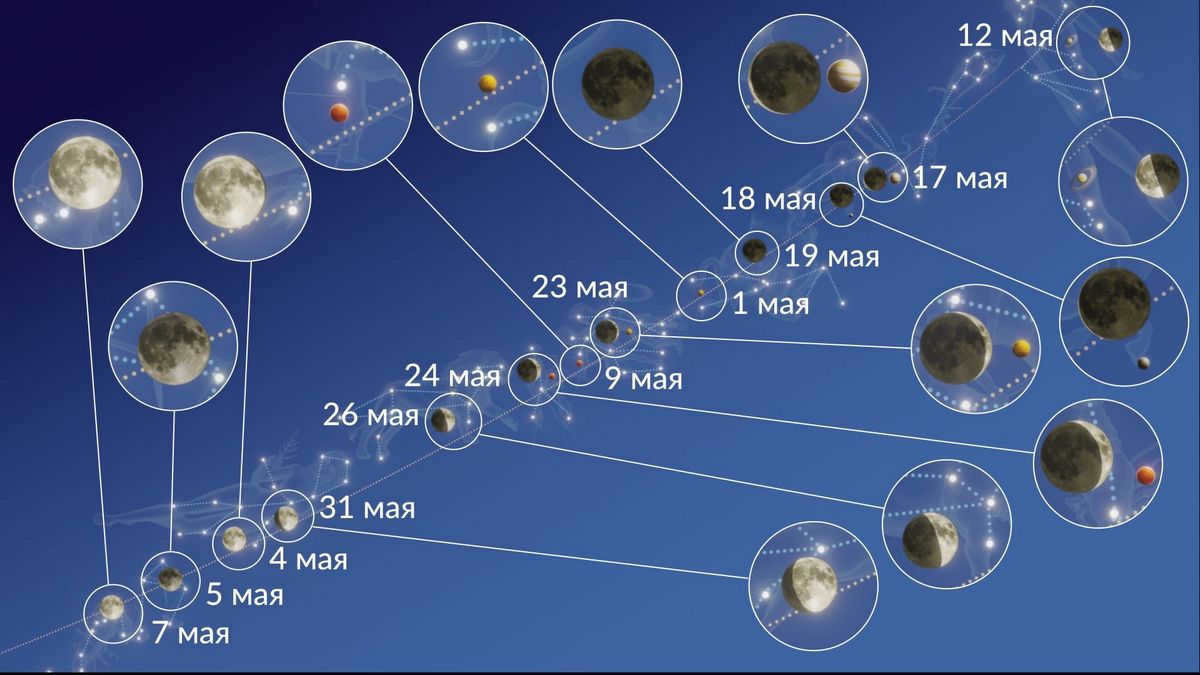
During the month of May in the year 2023, those with an interest in astronomy will have the opportunity to witness a variety of breathtaking celestial occurrences. These include the mesmerizing sight of stars illuminating the night sky, the captivating alignment of the Moon and planets, and the awe-inspiring event of a lunar eclipse. To ensure you never miss out on any of these remarkable events, we highly recommend downloading the Sky Tonight app for instant access to an always up-to-date astronomical calendar.
Astronomical happenings in May 2023
Please take note that the information provided is relevant for locations situated at mid-latitudes. In cases where the exact time is not specified (such as evening or morning), the event can be observed during the night.
- May 1st: Venus (with a sidereal magnitude of -4.2) will be positioned 2°57' away from Elnath.
- May 4th: Spica (with a sidereal magnitude of 1.0) will be positioned 2°07' away from the Moon in the morning.
- May 5th: Flower Moon; a penumbral lunar eclipse will occur.
- May 6th: the meteor shower of the Aeta Aquaridae will reach its peak.
- May 7th: Antares (with a sidereal magnitude of 1.1) will be positioned 6° away from the Moon in the morning.
- May 9th: Mars (with a sidereal magnitude of 1.4) will pass within 5° of Pollux (with a sidereal magnitude of 1.2).
- May 10: The Aeta Lyrida meteor shower reaches its peak on May 10.
- May 12: On May 12, Saturn (sidereal 1) will be 3°17' away from the Moon.
- May 17: Jupiter (sidereal magnitude -2.0) will come within 47' of the Moon on May 17. This event will be visible from parts of the Americas and Europe.
- May 18: On May 18, Mercury (magnitude 1.6) will pass 3°35' from the Moon.
- May 19: New Moon.
- May 21: In the evening of May 21, the star Elnatus (sidereal magnitude 1.65) will be 3°25' away from the Moon.
- May 23: On May 23, Venus (sidereal magnitude -4.3) will pass 2°12' from the Moon. In the evening, the star Pollux (sidereal magnitude 1.2) will be 3°48' away from the Moon.
- May 24: The Moon will be 3°39' away from Mars, which has a sidereal magnitude of 1.6.
- May 26: In the evening, the Moon will be 5° away from Regulus, which has a sidereal magnitude of 1.4.
- May 29: In the morning, there will be a great alignment of Uranus, Mercury, Jupiter, Neptune, and Saturn. Mercury, with a sidereal magnitude of 0.4, will be at its greatest westerly elongation. Venus, with a sidereal magnitude of -4.5, will pass 3°58' away from Pollux, which has a sidereal magnitude of 1.2.
- May 31: In the evening, the Moon will be 4°51' away from Spica, which has a sidereal magnitude of 1.0.
Planets in May 2023
North Hemisphere
Mercury (with a sidereal magnitude of 0.8) can be seen in the morning during the latter part of the month. Keep an eye out for it in the Aries constellation. Venus (with a sidereal magnitude of -4.3) is visible in the evening in the western sky during the beginning of the month in Taurus, and in Gemini towards the end of the month. As it moves further away from the Sun, Venus becomes brighter each month. Mars is not as bright (with a sidereal magnitude of 1.5) and can be found high in the western sky in Gemini. Towards the end of the month, it moves into the Cancer constellation. Jupiter (with a magnitude of -2.0) can be seen near the eastern horizon in Aries towards the end of the month. Saturn (with a sidereal magnitude of 0.9) is also visible in the morning, low in the southeast in Aquarius. If you have a telescope, you may be able to spot Neptune (with a magnitude of 7.9) low on the horizon in the morning, in the Pisces constellation. You will have approximately an hour to observe the planet.
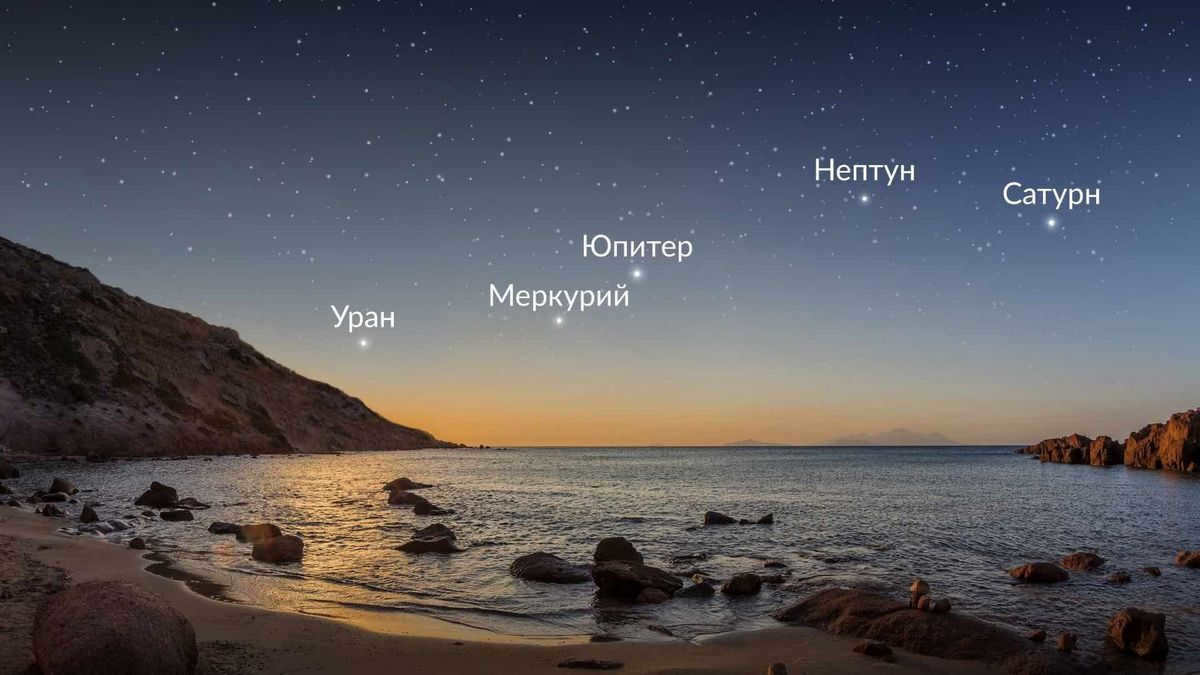
The Southern Hemisphere
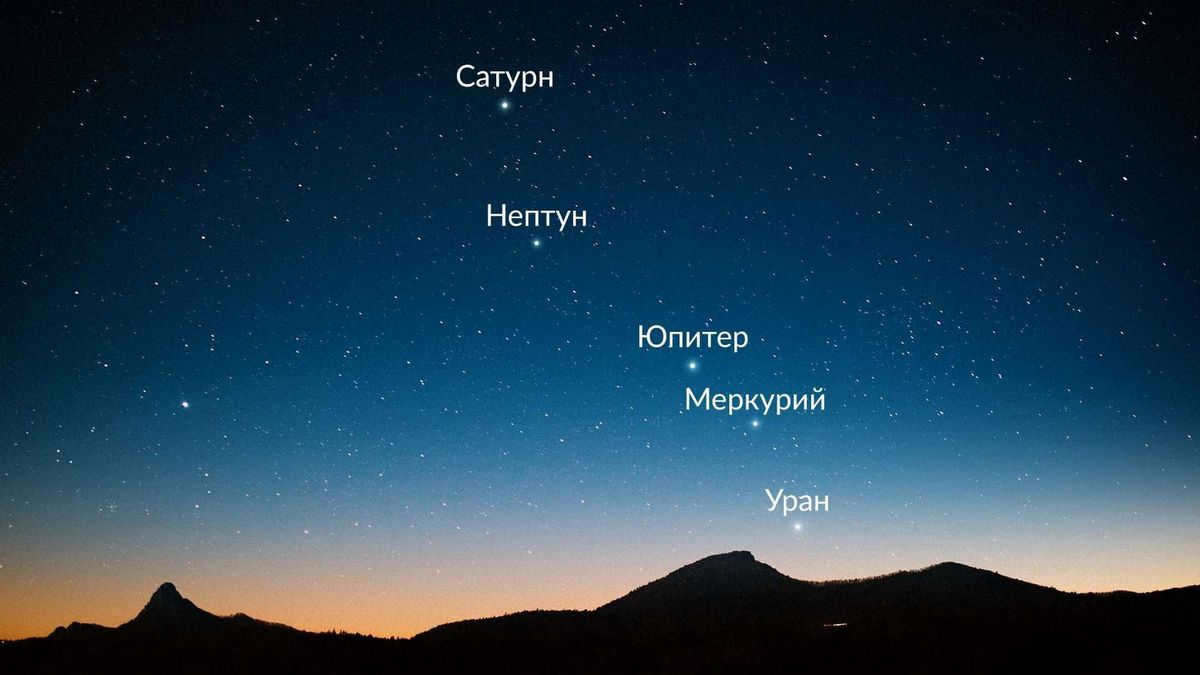
A penumbral lunar eclipse expected in May 2023
Mark your calendars for May 5, 2023, as a penumbral lunar eclipse is set to grace the skies. This celestial event will offer a stunning celestial show, fully visible from Asia and Australia, and partially visible from Africa, Eastern and Central Europe.
Contrary to popular belief, a penumbral eclipse can indeed be observed with the naked eye, although there are certain conditions. Only those eclipses with a penumbral magnitude lower than 0.60 remain invisible to the naked eye. However, the upcoming May eclipse boasts a magnitude of 0.9655, ensuring that it will be visible without the need for any additional equipment. For further details on the eclipse’s magnitude and its exact timing, be sure to check out our dedicated article.
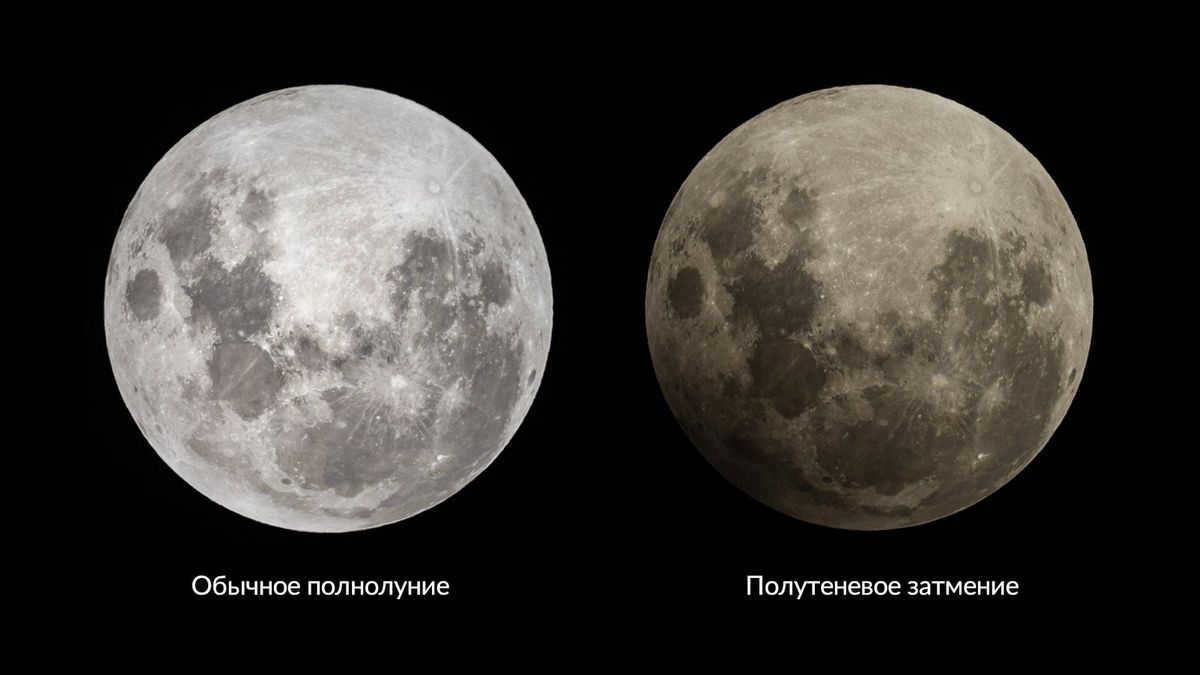
Comets in May 2023
There are no expected bright comets in 2023. To witness a truly remarkable celestial event, you will have to wait until 2024. However, if you are eager to observe comets sooner, here are a few that you can spot this month using a telescope.
If you are located in the Southern Hemisphere, you will have the opportunity to see C/2017 K2 (PANSTARRS) in May. Look for the comet in the evening sky, high above the western horizon until mid-month. C/2017 K2 will have a star magnitude of approximately 8. In the latter half of the month, it will be visible both in the evening and morning skies. Utilize the Sky Tonight app to locate the comet in the sky.
The comet C/2021 T4 (Lemmon) can be seen by observers in the Southern Hemisphere from May to September. It is getting closer to the Sun and its closest approach will be on July 31, 2023. On July 20, 11 days earlier, it will be at its maximum approach to Earth. Currently, the comet has a magnitude of 13-12, but this could increase to 8 by July.
Another interesting object to observe is 81P/Wild. It is still relatively close to Earth, which makes it bright with a magnitude of 13. This comet can be seen from both hemispheres, but it is more visible in southern latitudes.
This month, two comets will reach their closest point to the Sun – C/2020 K1 (PANSTARRS) on May 9 and 237P/LINEAR on May 14. C/2020 K1 (PANSTARRS) is expected to become as bright as a star with a magnitude of 11 or possibly even brighter. On the other hand, there are no accurate predictions for the brightness of 237P/LINEAR. During its last closest approach to the Sun in 2016, 237P/LINEAR had a stellar magnitude of 10. C/2020 K1 can only be observed from locations in the southern latitudes, while 237P/LINEAR can be seen from both the northern and southern hemispheres. However, it will be higher above the horizon in the Southern Hemisphere.
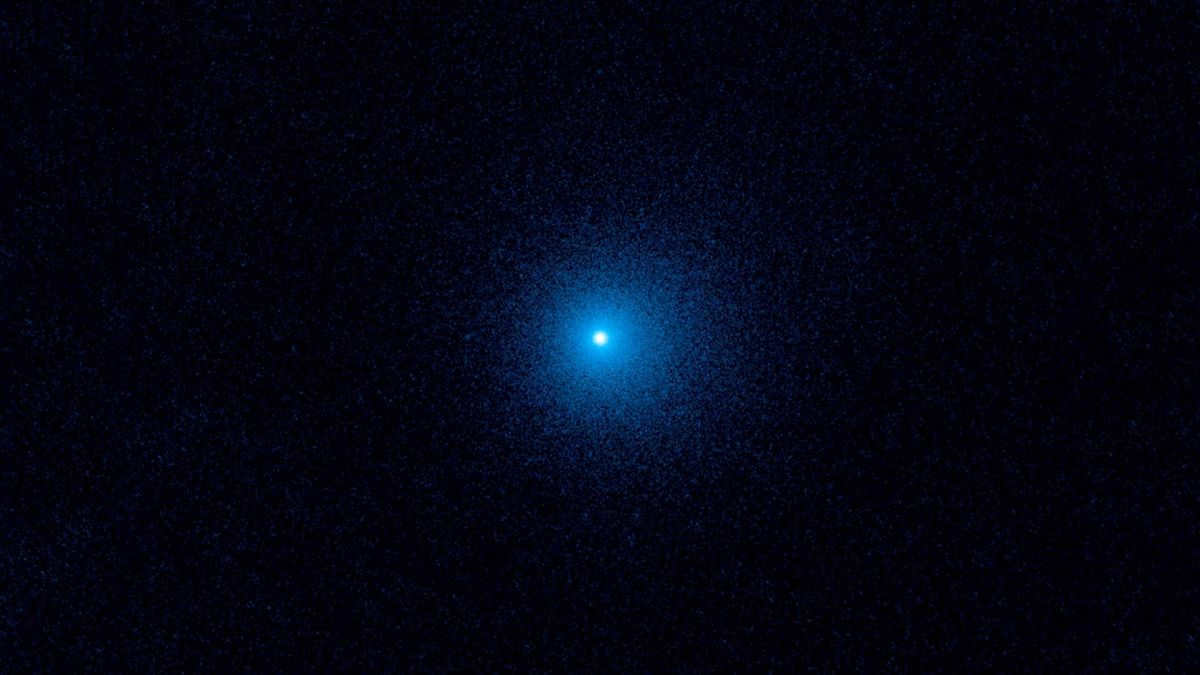
May 2023 Meteor Streams
In May 2023, there will be two meteor streams with peak activity: the Eta Aquarids on May 6 and the Aeta Lyrids on May 10. During the peak of the abundant Eta Aquarids, observers in the Southern Hemisphere typically witness up to 50 meteors per hour. However, this year, experts are predicting an increase in activity with up to 120 meteors per hour! Unfortunately, the full Moon will hinder observations.
The Eta-Lyrids, on the other hand, are much fainter. At their peak, they produce approximately 3 meteors per hour. Given that the Moon will be 77% illuminated on May 10, it will be challenging to observe them. To find out the best times to witness “shooting stars,” consult our meteor shower calendar.
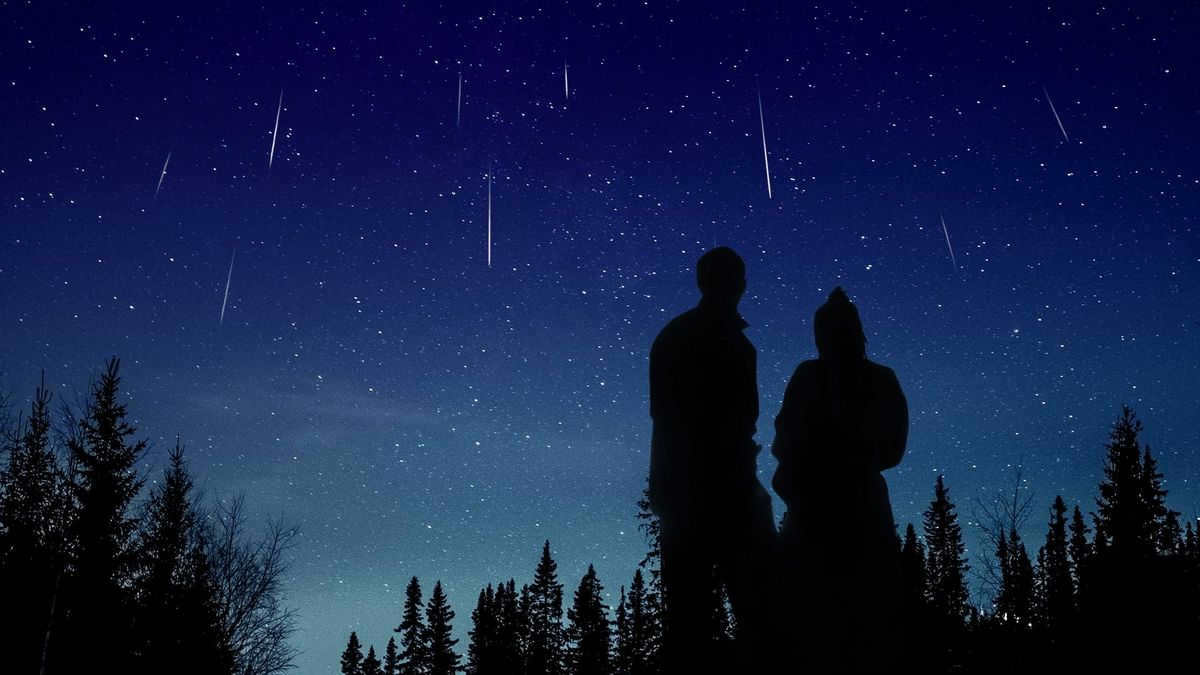
How can I locate objects in the sky?
One simple method for navigating the night sky is to utilize an astronomy application. This type of app can assist you in identifying and locating celestial objects, as well as provide information on optimal viewing times and more. If you are interested in locating stars, planets, and constellations, Star Walk 2 is a suitable choice. This app offers stunning graphics and relaxing music, enhancing the enjoyment of stargazing.
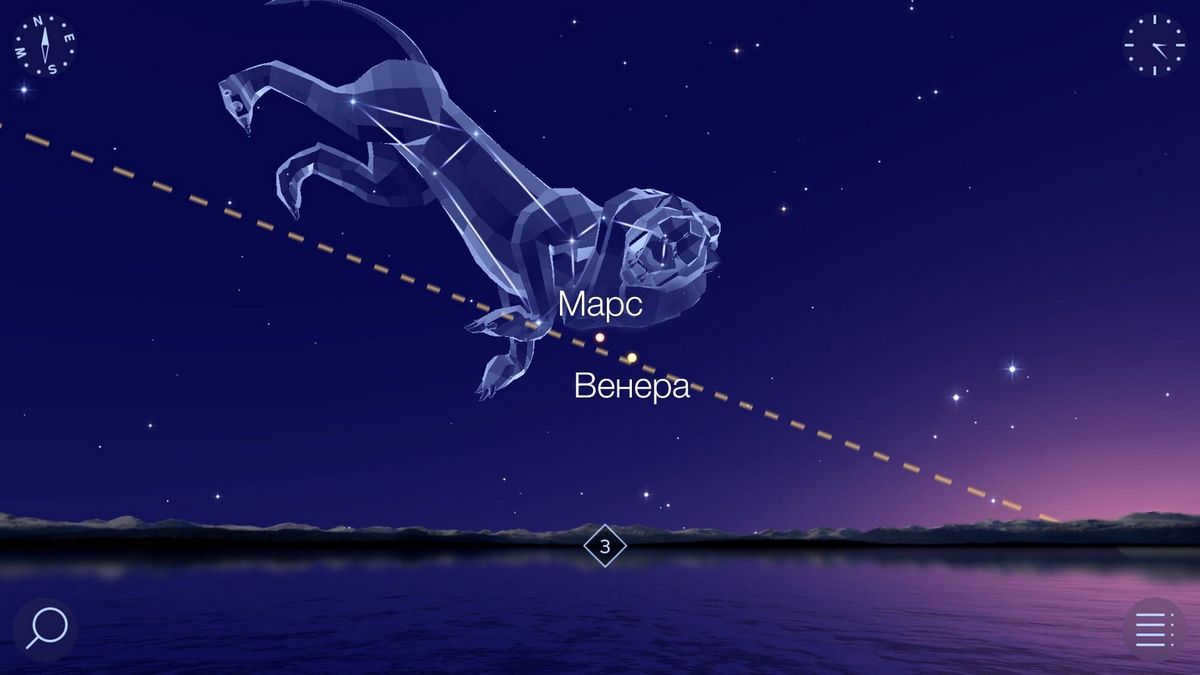
If you’re looking for a more advanced way to observe the sky, Sky Tonight is a great option. It offers a vast database of celestial objects, all of which are accessible for free. You can easily locate galaxies, comets, asteroids, nebulae, and other fascinating objects without having to make any additional purchases. Sky Tonight also provides features such as reminders, scheduling observations, visibility charts, and much more.
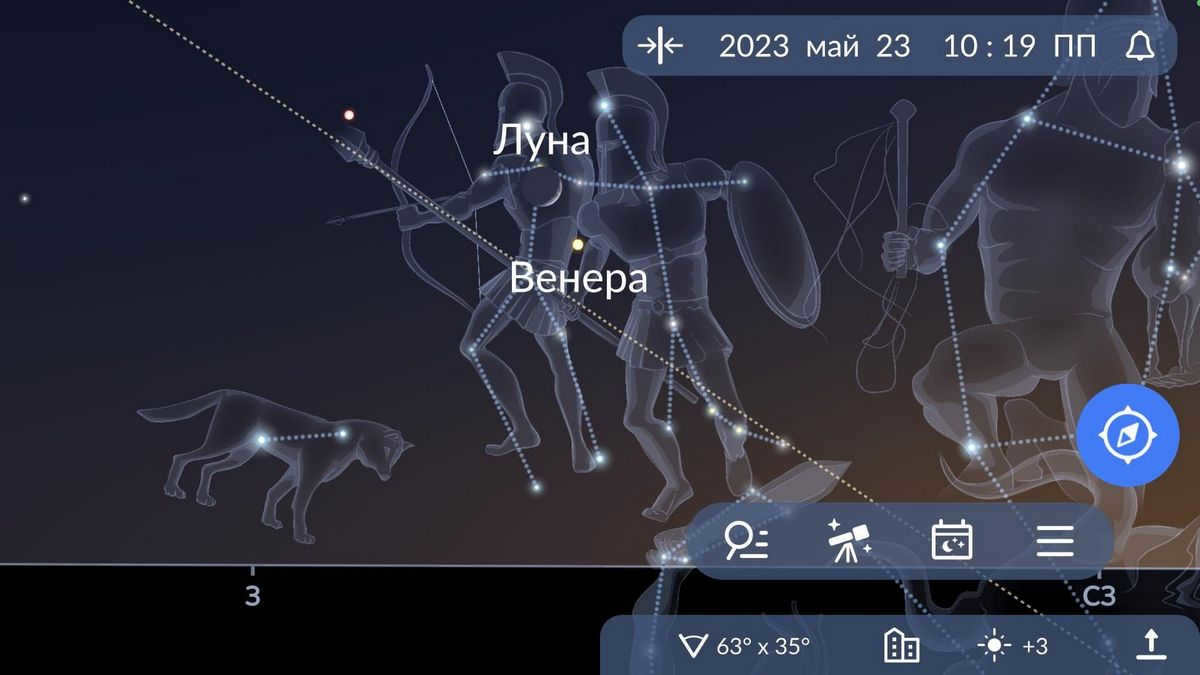
Summing it up
In May 2023, you will have the opportunity to witness the presence of all the planets in our solar system, the peak activity of two meteor streams, the appearance of multiple comets, and a penumbral lunar eclipse. To locate these celestial objects or events in the nocturnal sky, make use of the Star Walk 2 or Sky Tonight applications. We extend our wishes for clear skies and fruitful observations!
Every night, the sky unveils a range of astronomical events, also known as celestial phenomena. While the constellations maintain their historical forms, the continuous movement of the moon and planets, the occurrence of meteor streams, the mesmerizing aurorae, and the fluctuations in the brightness of variable stars ensure that each night’s sky is distinct and unparalleled. What astronomical events and phenomena can we anticipate for July 2023?
Overview of the starry sky in July
The appearance of the starry sky in July varies significantly depending on the observer’s geographic latitude. For those located in southern Russia, there is a good chance of witnessing a complete starry sky. They can observe the spring constellations in the evening, all the summer constellations visible at this latitude, and some of the fall constellations in the early morning sky. In the central region of Russia, the sky only becomes sufficiently dark in the middle of July. Astronomical twilight begins on July 11 at the latitude of Moscow. Although it is not yet nighttime, astronomical twilight allows for the enjoyment of the starry sky. In St. Petersburg, astronomical twilight arrives in August, so it is only towards the end of July that some bright summer constellations can be seen in the sky.
Observing the Western Sky in July
Imagine yourself in the middle of July, around midnight, gazing towards the west. A brilliant celestial body catches your attention – it is Arcturus, the most luminous star in the Volopassus constellation.
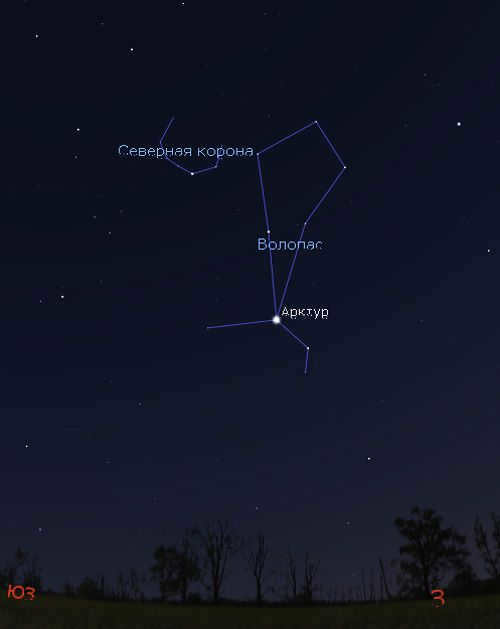
In July, you can observe the constellations of Volopas and the Northern Crown in the west-southwest. This information is provided by Stellarium, a popular software for stargazing.
During the summer months, Arcturus, a star associated with the spring season, can be seen slanting towards the horizon. Due to its relatively low position, Arcturus often appears to twinkle. Its color is easily distinguishable as orange or slightly reddish.
The constellation of Volopas is quite striking and can be likened to either an ice cream cone or a parachute with slings, with Arcturus representing the parachutist.
It is worth noting that to the left of Arcturus, in the southwest, you can find the small yet elegant Northern Crown constellation.
To the south and southwest lies a sprawling expanse of sky dominated by the constellations of Serpentor, Snake, Hercules, and Scorpius. Within this vast region, there is only one exceptionally brilliant star that commands attention. This star, known as Antares, serves as the alpha of Scorpius. However, due to its position very close to the horizon, it fails to capture the gaze when observed from St. Petersburg at the given latitude. Furthermore, its radiance is diminished by atmospheric extinction. Nevertheless, when viewed from Moscow, Antares is visible to a satisfactory degree, and in the southern regions of Russia, it shines brilliantly!
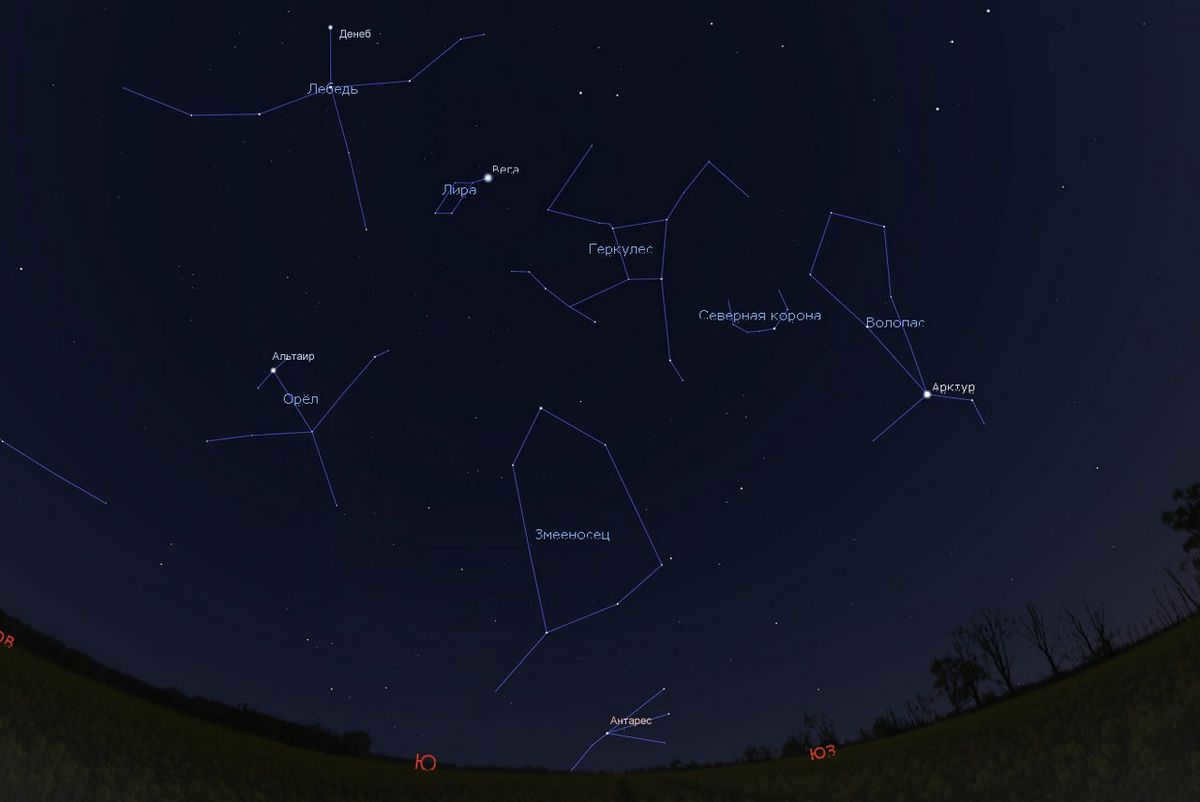
In July, the night sky is adorned with a magnificent sight – the Great Summer Triangle. Comprised of three brilliant stars – Vega, Deneb, and Altair – this asterism dominates the southeastern region. Each star corresponds to a different constellation: Vega shines the brightest in Lyra, Deneb serves as the primary star in Cygnus, and Altair guides the way in Aquila.
During midnight, Vega and Deneb reach impressive heights in the sky, nearly reaching the zenith in southern Russia. Meanwhile, Altair is positioned halfway between the zenith and the horizon.
The most distinct pattern of stars in this region of the celestial sphere is The Swan. Its shape resembles a cross, but upon closer inspection, one can discern the stars on the arms of the cross, which take the form of wings outstretched like a soaring bird. Of course, for this captivating sight to be visible, the night sky must be sufficiently dark.
The summer triangle serves as a prominent marker in the summer night sky. It serves as a guide to locate almost all of the constellations that dominate the summer sky, including Arrow, Dolphin, Foxy, Hercules, Shield, Sagittarius,…
July’s Night Sky: Eastern and Northern Views
In the eastern part of the sky, the fall constellations are beginning to rise. One prominent star pattern in this area is the Pegasus square, which consists of several second magnitude stars arranged in a quadrangle shape. If you look to the left of the square, you’ll see a chain of stars with similar brightness that make up the constellation Andromeda.
If you shift your gaze far to the northeast, you’ll spot the constellation Perseus with its leading star Mirfak. And in the north, close to the horizon, you’ll find Capella, which is the brightest star in the constellation of Auriga. While Auriga is officially a winter constellation, it can still be observed during the fall months.
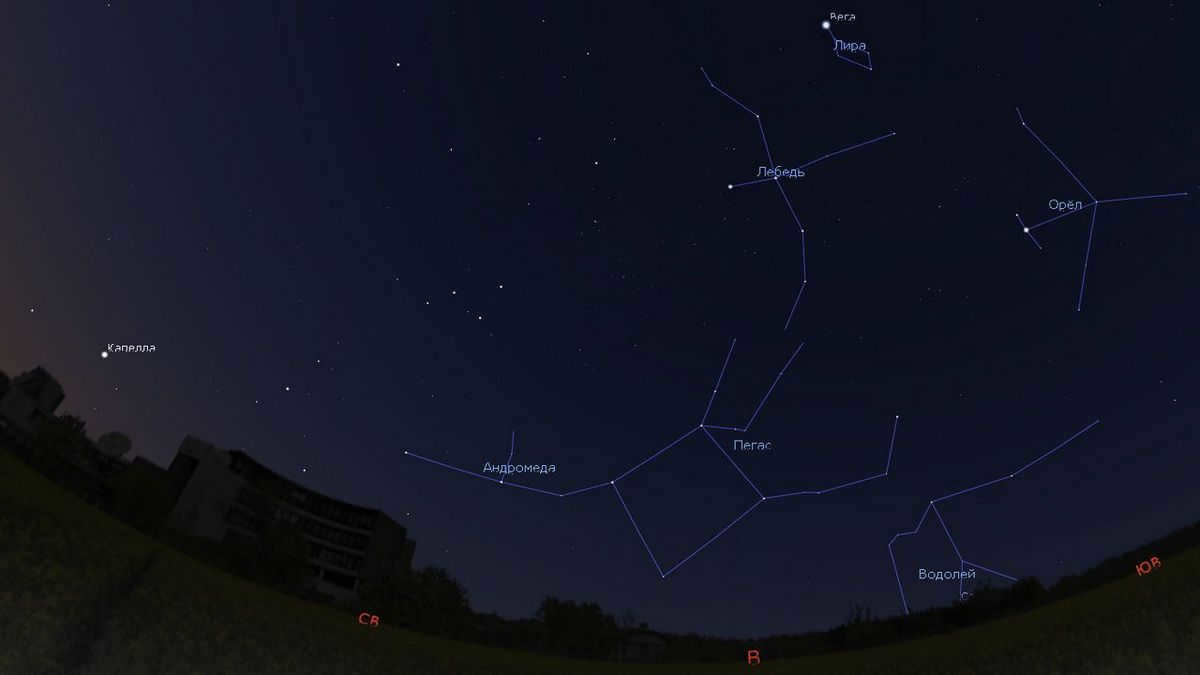
A stunning display of stars fills the sky in July, particularly in the eastern and northeastern directions. This captivating image was captured by Stellarium.
Moon and Planets in July 2023
For more information on the visibility of planets in July 2023, refer to our dedicated article. It is worth noting that due to the shorter nights, the planets may not be as prominent and can be observed either in the evening or morning sky. Saturn, however, can be seen rising around midnight.
Fortunately, the Moon comes to the aid of observers. In the twilight sky, our natural satellite outshines the planets, making it easier to spot. With its 27.5-day orbit, the Moon passes by all the planets within this timeframe, sometimes even helping to locate them.
- During the night of July 7th, Saturn can be seen near the Moon. Both celestial bodies remain visible in the sky until dawn, appearing low in the southeasterly direction.
- On the night of July 9th, the Moon is in close proximity to Neptune.
- On July 12th, in the morning hours, the waning crescent Moon can be seen near Jupiter.
- During the morning of July 13th, the Moon is positioned near Uranus.
- On the evening of July 19th, the thin crescent of the Moon is located near Mercury in the sky. Please note that this observation is only possible in southern Russia.
- On the evening of July 20th, the Moon passes by Venus and Mars in the sky. Similar to the previous observation, this event can only be witnessed in southern Russia.
Meteor activity in July 2023
Expect peak activity on July 30th from two meteor showers, the alpha Capricornids originating from the Capricorn constellation and the Southern Delta Aquariids originating from the Aquarius constellation. These showers are relatively small, with the alpha Capricornids producing a maximum of 5 meteors per hour and the Southern Delta Aquariids producing 20-25 meteors per hour. Both showers are best viewed from the southern hemisphere of the Earth. However, towards the end of the month, meteor activity will increase with the emergence of the Perseids!
In the middle zone of Russia, around the latitude of St. Petersburg and further north, an extraordinary phenomenon can be witnessed during the month of July – the presence of unique silver clouds. These clouds are unlike any ordinary clouds, as they form at an altitude of approximately 80 kilometers above the Earth’s surface. While they may appear similar to fluffy clouds, these silver clouds possess a distinct and striking silvery-white hue. It almost appears as if they are illuminated in the twilight sky, reflecting the sunlight even after the sun has already set for observers on the ground.
The silver clouds can be observed in the northern part of the sky, above the remnants of the evening dawn. The optimal time to witness this awe-inspiring phenomenon is during the month of June and the first half of July. Due to their unpredictable nature, the appearance of silver clouds can provide an unexpected and truly unforgettable experience for amateur astronomers.
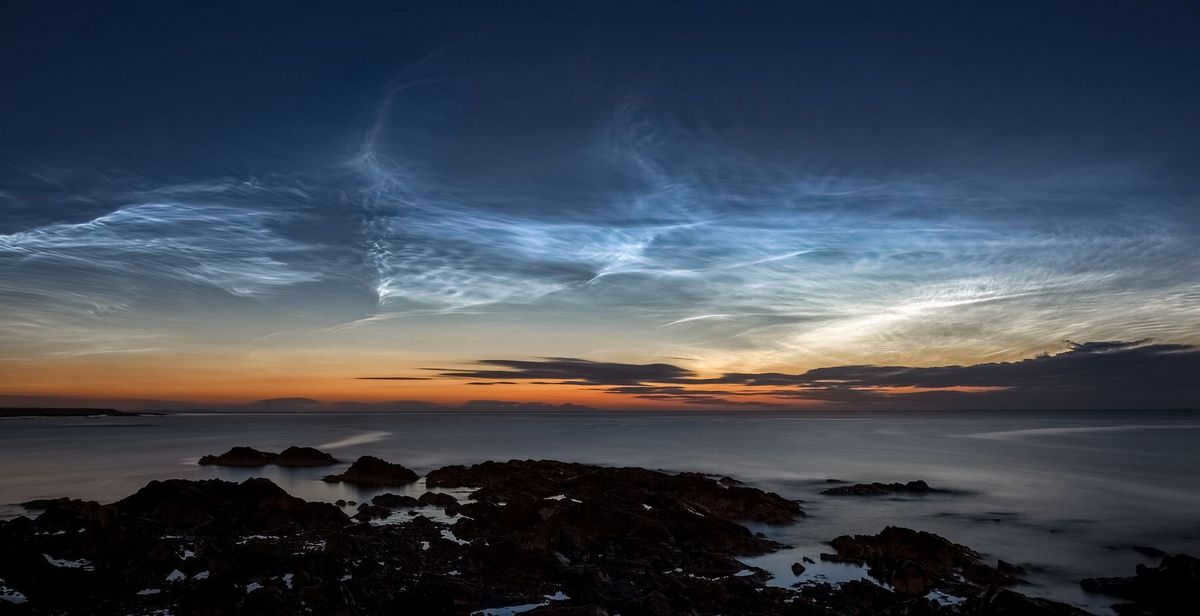
Shimmering clouds adorn the night sky. Photo: Carl O’Beirnes
Here is a concise overview of the captivating astronomical occurrences in July 2023.
Astronomical occurrences and phenomena in July 2023
The date of the event is listed in the first column, while the second column provides a description of the astronomical event. The Time column indicates the specific time of day that the event can be observed. If the event is not visible at the specified time (e.g., due to being in the daytime sky), it is marked as N/A. The “Where to Look?” column indicates the direction in which the event can be observed, with W representing west, E representing east, SE representing southeast, and so on. If there is a dash in the column, it means that the celestial event can be observed in different parts of the sky at different times during the night.
| July 1 | Mercury in an upper conjunction with the Sun | — | N/A | The planet moves into the evening sky |
| July 1 | Moon passes 1° north of the star Antares | Night | S | |
| July 1 | Neptune transitions from direct motion to sideways motion | — | N/A | |
| July 3 | Full Moon | All night | S | |
| July 4 | Moon at perigee | All night | S | The distance to the Moon will be 360,149 kilometers |
| July 6 | Earth at aphelion | — | — | Earth will be at the farthest point of its orbit from the Sun at a distance of 152,093,251 km or 1.0167 a. e. |
| July 7 | The Moon passes 2° south of Saturn. | Morning | SE | |
| July 8. | Moon passes 2° south of Neptune | Morning | SE | |
| July 10 | Moon in last quarter phase | Night, morning | W, SE | |
| July 11 | The moon passes 2° north of Jupiter | Morning | E | The Moon is in the vicinity of Jupiter on the night of July 12 |
| July 12 | Moon passes 2° north of Uranus | Morning | E | |
| July 14 | Moon passes 9° north of the star Aldebaran | Morning | NE | |
| July 17 | End of evening visibility of Venus | Evening | NE | |
| July 17 | New Moon | — | N/A | |
| July 20 | Moon at apogee | Evening | W | The distance to the Moon will be 406,289 kilometers |
| July 21 | Venus transitions from sideways to direct motion | — | N/A | |
| July 25 | Moon passes 2.8° north of the star Spica | Evening | SSW | The Moon is near the star on the evening of July 24 |
| July 26 | Moon in first quarter phase | Evening | SOUTHWEST | |
| July 28 | Moon passes 1° north of the star Antares | Evening | SW | |
| July 30 | Maximum activity of the meteor shower Alpha Capricornidae | Night | — | ZHR=5 |
| July 30 | Maximum activity of the meteor shower southern delta Aquariids | Night | — | ZHR=25 |
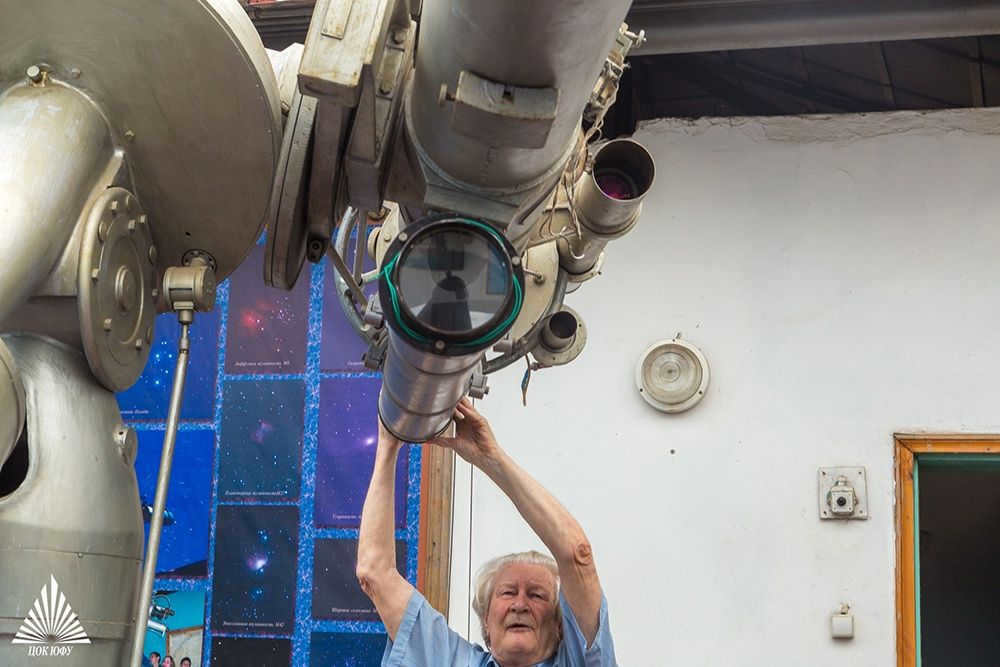

Mikhail Nevsky, the director of the observatory at the Department of Space Physics of the Southern Federal University, shared fascinating insights about the wonders that await us in the starry sky.
March – April – May
Many individuals are curious as to whether the Neanderthal’s comet, the one characterized by its green tail and visible in late January through early February, has receded into the distance. And when will we encounter it again? Not for another 50,000 years, and even then, it’s uncertain due to potential alterations in its trajectory caused by our massive planets. The previous time it approached, only the Neanderthals had the privilege of admiring it. Currently, comet C/2022 E3 is steadily moving further away.
During the beginning of March, two luminous entities will be visible in the southwestern sky. Venus and Jupiter will align in a straight line and emit a majestic sparkle. The most impressive conjunction of Venus and Jupiter will take place at the end of the month, with Venus surpassing Jupiter’s brilliance by a factor of six.
In early April, there is a unique opportunity to spot Mercury in the rays of the setting sun, as it will be at its farthest distance from our star. On April 20th, there will be a rare hybrid solar eclipse. Depending on the location of observation, it will appear either as a total eclipse or as a ring-shaped eclipse. However, to witness this event, one would need to travel to Australia, New Zealand, or Thailand.
During the night of April 22nd and 23rd, the peak of the first spring stargazing event will occur, featuring the Lyrid meteor shower. This meteor shower is caused by a trail of dust left behind by Comet Thatcher. It is possible to see up to 18 meteors per hour, and occasionally even up to 90. The comet completes one orbit around the sun every 415 years, with its last approach occurring in 1861. The next time it will come close to the sun will be in 2276. Hence, the meteor shower is not as abundant in our time.
Mark your calendars for May 6-7. Get ready for an upcoming celestial event – the Eta Aquarids, also known as the May Aquarids. These meteors are known for their swift speed and long-lasting trails. They are created by the renowned Halley’s Comet, which used to instill awe with its luminous tail. You can expect a density of 50-70 meteors per hour. Typically, they are best observed after midnight, in the early morning hours. In the words of the poet Yesenin: “Before the dawn. Azure. Early. And shooting stars grace the sky. I would like to make a wish. But I am unsure of what to wish for.”
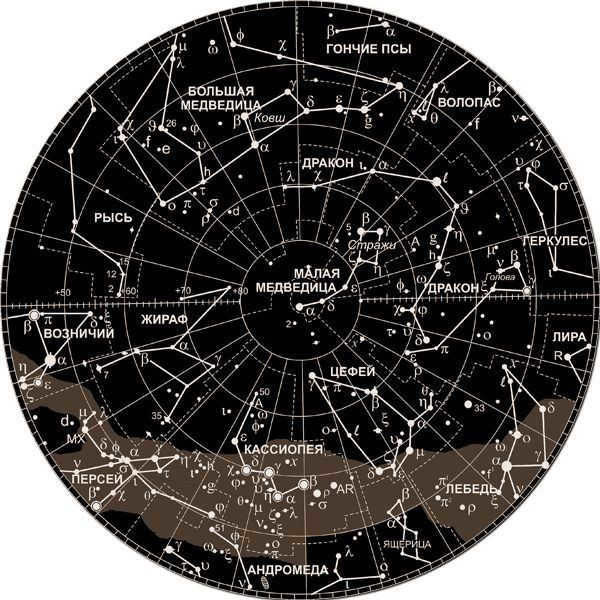
If you are having trouble spotting anything other than the Big and Little Dipper in the night sky, a constellation map can be quite useful. Photo: prao.ru
June – July – August
During the night of July 28th and 29th, the Southern Delta Aquariids meteor shower originating from Aquarius will reach its peak. The maximum number of meteors per hour is not expected to exceed 20, which means that approximately every three minutes, a meteor can be observed. Admittedly, this is not a particularly high rate.
August is an ideal month for amateur astronomers due to the warm and stable weather conditions. The Perseids meteor shower, which is caused by the debris left behind by comet Swift-Tuttle, promises to provide a great viewing experience. The peak activity of the Perseids is expected on August 12-13. During this time, the moon will only be in its crescent phase, minimizing its brightness and ensuring that it does not interfere with the visibility of the meteors. Up to one hundred meteors per hour will burn up in the Earth’s atmosphere, making this one of the most spectacular celestial events of the year. The meteors typically have long trails that can be observed for a few seconds, and they are predominantly visible in the early morning hours.
August 27th. – Saturn’s closest approach to Earth. It can be seen in the early morning hours in the southwest, just above the horizon. This year, we are fortunate as the rings of Saturn are fully extended and can be observed through a telescope, appearing as a thin thread. It is also possible to observe Saturn’s moon – Titan.
On the nights of August 30th and 31st, we will witness a supermoon. When a large and bright Moon rises above the horizon, it often causes a sense of panic: “Why is it so big?”. However, this can be easily explained. The Moon does not move in a perfect circle, but rather follows an elliptical orbit. When the closest point of its orbit to Earth coincides with a full moon, the satellite appears about 10 percent larger than usual. Additionally, the Moon’s unusual color is influenced by our atmosphere.
September – October
On September 19th, Neptune will approach Earth, becoming visible in the Pisces constellation. However, it cannot be observed with the naked eye, appearing only as a small blue disk when viewed through a telescope.
On October 9th, the Draconid Meteor Shower will reach its peak. While this meteor shower is not very prolific, producing only about 10 meteors per hour, there are occasional intense outbursts when “shooting stars” can fall at a rate of several hundred per hour. In rare cases, meteor storms can occur, with the number of meteors surpassing a thousand per hour, or even ten thousand.
The fall Orionids meteor shower will be visible from October 21 to 22. This event occurs when the Earth passes through the orbit of Halley’s Comet, although we won’t actually be crossing paths with the comet itself. Instead, we will encounter the trail of particles that have broken away from the comet’s nucleus. The Orionids enter our atmosphere at a staggering speed of 66 kilometers per second, leaving behind bright white trails.
November to December
On November 3rd. Jupiter will be getting closer to us. It can be observed all night through a telescope. The planet will rise in the east in the evening and will be low in the south by midnight. We will be able to see its powerful atmosphere, cloud bands, and the incredible vortex known as the “hurricane eye”. This vortex has been visible for centuries, although it is not as intense as it used to be during Halley’s time. The wind speeds on Jupiter are absolutely incredible! We will also be able to see Jupiter’s largest satellites, which appear as bright spots on both sides of the planet.
On November 14. Uranus will reach the opposition. It is so far away that a telescope will be necessary to observe it.
On December 14th, Earth will pass through the Gemenid meteor shower, which originates from the asteroid Phaethon. Unfortunately, the weather conditions are not ideal for observations, but it is still worth braving the cold and looking up for half an hour.
From September to the end of March, you have the opportunity to witness the Northern Lights. To have the best chances, you need to venture beyond the Arctic Circle. The lights will be most visible near locations like Murmansk, Khibiny, Arkhangelsk, Vorkuta, and Khatanga. The intensity of the Northern Lights depends on the activity of the Sun, which is currently at the peak of its 11-year period. This means there are greater chances of witnessing the Northern Lights in all their glory.
August is the month when the famous Perseids meteor shower takes place. The peak of the shower is expected from August 11th to 13th. During this time, it will be possible to see approximately 100 meteors per hour at the highest point in the sky (zenith), or 1-2 meteors per minute.
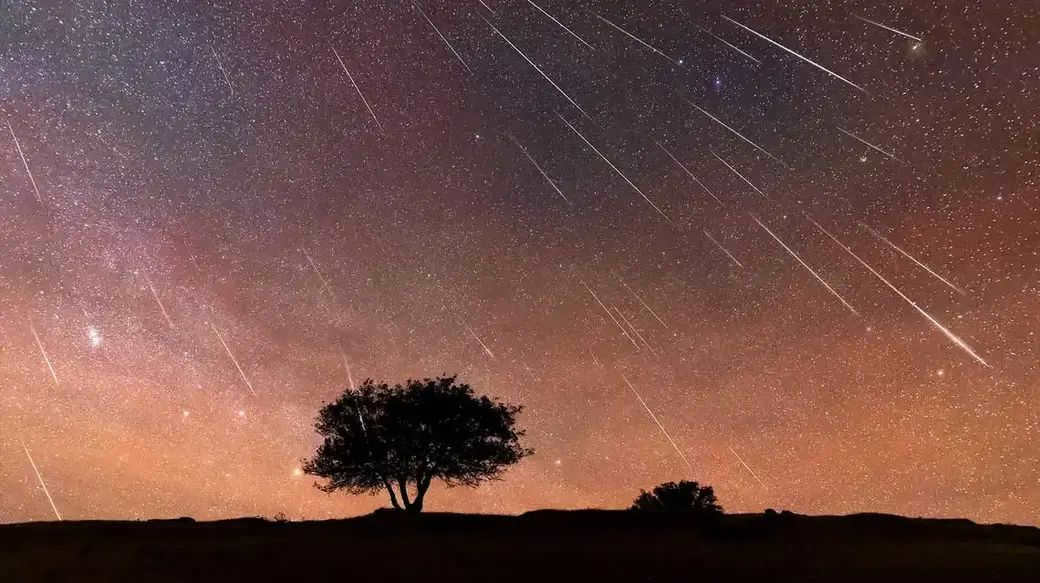
Every summer, between mid-July and the end of August, there is a meteor shower that originates from the constellation Perseus. This information comes from starwalk.space, a website dedicated to astronomy enthusiasts.
The Perseids can be observed from July 17 to August 24, but the peak of the meteor shower in 2023 falls on the nights of August 11-12 and 12-13. During these two summer nights, it is possible to see approximately 100 meteors per hour at the zenith, which is equivalent to 1-2 meteors per minute.
What is the cause of the Perseid meteor shower?
The occurrence of the Perseid meteor shower is attributed to the Earth passing through a path of particles that were left behind by a comet. Each meteor shower is associated with a specific celestial body, and in the case of the Perseids, it is the comet 109P/Swift-Tuttle. Despite the fact that this comet only comes close to our planet once every 133 years, we are able to witness the Perseids annually due to Earth intersecting the trail of debris it leaves behind each year.
Where can I observe the Perseids meteor shower in the sky?
During the Perseids meteor shower, the “shooting stars” appear to originate from a specific point in the sky known as the radiant. The radiant of the Perseids meteor shower is located in the constellation Perseus. To locate it in the sky, you can use stargazing apps like Star Walk 2 and Sky Tonight. These apps have user-friendly search engines that allow you to enter the name of the meteor shower and find the current position of the radiant in the sky above you.
Tips for observing meteors
To begin your meteor observation, start in the evening before the moon rises. Look for a location with an unobstructed view of the sky and minimal light pollution from urban areas. It is even more ideal to venture to higher altitudes, such as mountains, where atmospheric haze and clouds will be below the observer.
Bring along a comfortable reclining chair or cot for optimal viewing. In case of limited space, a mat can suffice, but make sure your head is elevated to prevent drowsiness caused by a rush of blood. This will help you stay alert and engaged.
Avoid creating a fire or using a bright flashlight, as this will impair your night vision and make it difficult to see most of the meteors. Instead, opt for a flashlight with a red filter, as it is better suited for preserving your night vision in darker conditions.





